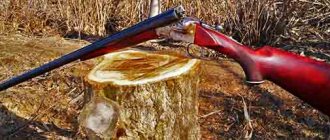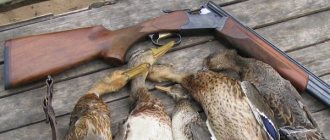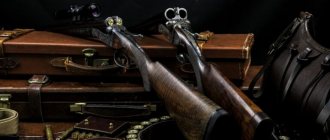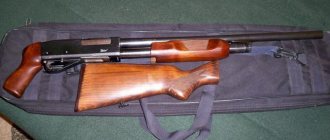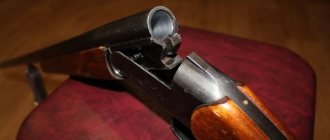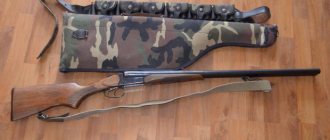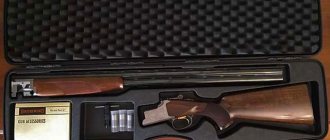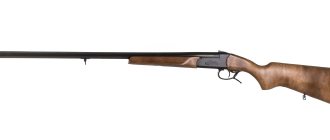The double-barreled intra-hammer vertical shotgun IZH-59 Sputnik, 12 mm caliber, was developed by Soviet engineers in the 60s of the last century. The main creator of this gun is design engineer A.A. Klimov. Serial production of the IZH-59 Sputnik vertical aircraft took place between 1960 and 1964. The gun was bought by amateur hunters, as well as athletes for trench shooting.
For domestic hunters, the IZH-59 Sputnik became the first available sideflight.
It’s difficult to call the IZH-59 sideflint a collector’s item; it’s more of an ordinary gun. At the same time, it has excellent quality indicators, as well as a stylish and attractive appearance. Hunters who have used the IZH-59 Sputnik talk about this gun, both in a positive and negative way, their opinions are divided.
History of creation
The history of the development of the IZH-59 Sputnik shotgun dates back to 1959, when a team of young engineers from IZHMEKH under the leadership of the famous designer A.A. Klimova began creating a fundamentally new double-barreled shotgun. The main task of enthusiasts was to create a smoothbore gun that would be accessible to the average consumer.
As a result, a few months later the first Sputnik rolled off the assembly line, which immediately attracted the interest of hunters. However, due to the fact that vertical double-barreled shotguns were slightly inferior to horizontal shotguns in popularity, production was curtailed already in 1964. During this time, 21,218 guns entered the market.
The design of the gun, which received the index IZH-59 (according to the year of development), was based on the classic Browning scheme - a hinged connection of the barrel block with the bolt box and a locking bar on one wide under-barrel hook. This absolutely correct choice of a technical solution, combining locking reliability with technological simplicity, provided Klimov’s design with the prospect of large-scale production at minimal cost.
For the first time in domestic weapons technology, the IZH-59 used a planless connection of two smooth barrels with a breech and muzzle coupling. This connection of barrels, in addition to reducing their weight, also improves the maneuverability of the gun and ensures independent temperature deformations of each barrel.
IZH-59, as a successful model of a gun with vertically positioned barrels, was noted literally immediately when it went on sale. Already in 1960, at the All-Russian Exhibition of Hunting and Fishing Equipment, the Izhevsk Mechanical Plant was awarded a Big Gold Medal and a First Degree Diploma for the successful development of new guns IZH-56-3, IZH-58, IZH-59.
Despite the fact that the IZH-59 existed for a relatively short time, many double-barreled shotguns with vertical barrels were developed on its basis, for example, the legendary IZH-12, as well as IZH-27, sports IZH-25, IZH-39 and others. All of these side-flight aircraft had many design similarities with the IZH-59, but it would still be wrong to consider them only a modification of Sputnik.
Note that Izhevsk guns are also marked with Latin letters: “MP”, which means: “Mechanical Plant”.
General description of IZH-59
A characteristic feature of the IZH-59 Sputnik gun is the detachable vertical barrels. The advantage of such barrels was often discussed in amateur hunting circles, and great attention to such designs provoked the emergence of new original models of different locking systems and opening planes. It was during this period that unusual shifters were developed, which open not downwards, but to the side.
The main advantage of a vertical barrel is a wider view when shooting, as well as higher mobility of the hunter during shooting. And this is true; it is rare to find a sideflint with a horizontal tent. But it should be noted that the triggers of vertical models periodically hit the strikers with different forces, and this can cause misfires over time.
Foreign analogue of the Soviet sideflint
“Merkel” is one of the expensive and very sophisticated models of “vertical” models, which has gained wide popularity in Germany. This gun became a fetish for entire generations of German hunters, and the possession of this weapon was a source of special pride.
High adaptability, excellent balancing and ease of control of the gun made this German sideflint one of the most popular among sports and hunting models on the arms markets in Germany. IZH 59 “Sputnik” enjoys exactly the same popularity among smoothbore shotgun connoisseurs in the Soviet Union. The analogue of the Russian model consists of three parts: the receiver, the barrel block and the forend. According to reviews from owners of German Merkels, the attachment of the forearm to the barrels in these guns is quite strong. The guns are equipped with very durable locking parts.
Design Features
The trigger mechanism is placed in the block and secured to a separate base (mast). It is possible to release the triggers without any impact. The design of the triggers is returnable, and they were installed as a separate element from the strikers. The hammers are cocked by levers, a hinge and rods when the barrel is opened, and the front hook is hinged and spring-loaded.
The mainsprings in this series were cylindrical and spiral. There are no inter-barrel rails, which makes the gun lighter and ultimately provides greater convenience for the hunter. This connection of trunks also creates conditions for independent temperature deformations characteristic of each individual trunk.
Other design features include:
- the stock is made of beech or walnut, and has a straight or pistol shape;
- the butt plate at the butt is made of plastic or equipped with a rubber shock absorber;
- the forend has an elongated shape and a detachable design; it is secured by a latch with a lever design;
- on the sides of the trunks in the area of the forend are covered with a wooden surface of the linings.
- drilling the trunks gives the effect of grouping the lower trunk in the front coupling by about 50%;
- ease of aiming is ensured by a high aiming bar soldered to the top of the barrel;
- the barrels are locked single-handedly, using a wide wedge and a hook on the breech coupling;
- In the open position, the locking lever is held in place by a latch, which automatically releases it during closing.
There were very few sports models in this series, although experienced hunters left quite positive impressions.
Operation of gun mechanisms
a) The position of the mechanisms when the triggers are pulled (after the shot - diagram 1).
The triggers (1) are released and the horns of the mainspring rod (2) are balanced in the “release” state. The cocking rods (3) are moved to the forward position by the bevels of the breech coupling hook (4) (diagrams Nos. 1 and 2). The mainsprings (5) are in the pre-compressed stage. The strikers (6) and (7) are recessed behind the plane of the block shield (8). The safety button (9) with the base (10), the locking spring (11), two safety flags (12) and their springs (13) are in the forward position. The locking bar (14), under the action of the locking spring (15) through the axis of the lever (16), tightly locks the breech coupling hook of the barrels. The locking lock (18) is lowered down with the barrel coupling.
b) Operation of mechanisms when opening barrels (diagram No. 2).
To open the barrels, use the thumb of your right hand to move the locking lever (19) all the way to the right, then gently shake the gun to open the barrels smoothly.
In this case, the locking lever turns its axis (16), the latter, through the intermediate stop (20), removes the locking spring. At the same time, the leash, located in the lower part of the lever axis, moves the locking bar back, removing it from engagement with the hook of the breech coupling of the barrels.
The locking lock (18) rises upward under the action of its spring and holds the locking bar (14) in the rear position. Together with the bar, the locking lever (19) and the lever axis are held in the open position.
The barrels together with the forend (21) and the hinge (22), rotating around the hinge axis (23), rotate the cocking levers (24) through the hinge, the latter push the rods (3) back, the rods, in turn, turn the hammers until they are set combat platoons whispered for the corresponding edges (26). At the same time, the mainsprings (5) are compressed. When the barrels are opened, the extractor (27) extends, removing the cartridges from the chambers.
c) Operation of mechanisms when closing barrels (see diagram No. 2).
When the barrels are closed, the triggers remain cocked. The rods return to their original (front) position with the side bevels of the breech coupling.
Using the bottom of the groove in its middle part, the breech clutch presses the locking latch downward and disengages it from the locking bar.
Under the action of the locking spring, the locking lever with the axis and the bar return to their original position, tightly locking the breech coupling of the barrels.
To compensate for the wear of the locking planes of the strap and the breech coupling, these planes are made at a slight angle to the plane of movement of the strap.
d) Operation of mechanisms when the fuse is turned on (see diagram No. 2).
To turn on the fuse, you must move the button (9) to the rear position. If the triggers were not cocked, the safety flags (12), having reached the protrusions of the sear, will turn slightly clockwise around their axis and compress their springs (13). When the triggers are subsequently cocked, the protrusions of the sears will drop lower and the fuse boxes, turning under the action of their springs, will firmly close the sears. It is impossible to fire a shot by pressing the triggers (28-29).
If, before turning on the safety, the triggers were cocked, when the button is pulled back, the flags immediately become above the sear protrusions, locking them.
e) Operation of mechanisms when firing a shot.
To fire a shot, you must turn off the safety, if it was on, take aim and smoothly press the trigger.
The front (right) trigger is connected to the sear of the lower barrel, the rear (left) - to the sear of the upper barrel.
When you press the trigger, the latter, through an intermediate rod (30 or 31), raises the corresponding sear and removes it from under the cocking of the hammer. The trigger, under the action of the mainspring, strikes the corresponding firing pin, after which, under the action of the lower horn of the mainspring rod, it returns somewhat back (the so-called “release” of the trigger). The firing pin also returns back to its original position. This return movement of the triggers contributes to a smoother opening of the barrels, because There is no deformation of the firing pin of the fired primer.
Technical characteristics of IZH-59
Distinctive features and performance characteristics of the Sputnik:
- The IZH 59 Sputnik is a firearm.
- According to its intended purpose, this model belongs to the hunting group.
- The weapon is equipped with smooth-bore barrels.
- The number of barrels for one gun is 2 pieces.
- The trunks are located in a vertical plane - side flint.
- In the manufacture of barrels, craftsmen use standard drilling: the half-choke is the lower barrel, the full choke is the upper.
- Combat nutrition is not carried out automatically.
- The trunk length is 75 cm.
- Weight - 3.5 kg.
- The weapon is designed to use twelve-gauge ammunition.
- The cartridge size is 12/70.
- Manufacturer: Izhevsk Mechanical Plant (USSR).
| Characteristic: | Parameter: |
| Type | shotgun |
| Number of trunks | two |
| Type of trunk connection | vertical |
| Weapon caliber | 12 (18.5 mm) |
| Barrel length | 750 mm |
| Chamber length | 70 mm |
| Ammunition used | 12/70 |
| Weapon weight | 3.5 kg |
The question of what ammunition to use for shooting from a Sputnik gun is one of the most pressing for both the hunting enthusiast and the athlete. In fact, the answer is quite simple: the model is not particularly fussy in its diet. Gunpowder can be either smokeless or smoky. The sleeves may have metal or paper jackets. The only limitation is the amount of gunpowder - it should not exceed the recommended amount (35 grams for 12 gauge).
It's worth noting that this gun doesn't perform very well with heavy ammo. It is designed for more skilled and experienced shooters, and in most cases is not suitable for beginners.
Today, in general, sleeved barrels are not that uncommon, and even the outdated Sputnik is in quite good demand among hunters.
Advantages and disadvantages
Judging by the numerous positive reviews, the IZH-59 shotgun is one of the best models among smooth-bore shotguns with vertical barrels. This is due to the following advantages:
- Good visibility while shooting. Due to the fact that the sighting bar is located several millimeters above the receiver, the shooter sees a much larger angle of the surrounding terrain while aiming. For a hunter who shoots at moving targets, this feature will be especially appreciated.
- High survivability. The service life of one gun is at least 8,000 shots (4,000 for each barrel) - a significant indicator for a vertical gun, the barrels of which are connected by couplings. However, this nuance is relevant only if we are talking about the use of ammunition with a standard load of gunpowder.
- Lightness of the weapon. Due to the fact that the barrels are connected without the use of a special strap, the weight of the gun is reduced by almost 300 grams. Thanks to this, the shooter gains additional maneuverability during shooting, and can also move around the forest almost all day long.
- The ability to release triggers without a hammer. This allows the shooter to closely observe how the firing pin works during shooting. Although it should be noted that using such a system for entertainment purposes can be dangerous.
But still, the Sputnik is not a weapon that is devoid of shortcomings. As you know, IZH-59 was the first vertical rifle developed by Klimov’s team. So it’s not surprising that the engineers did not take into account several shortcomings that customers now often complain about:
- Frequent misfires at the lower trunk. The fact is that the triggers of different chambers hit the primers with different forces. Because of this, the gun sometimes simply does not fire, and using misfired ammunition can be hazardous to health. So it turns out that you have to throw away almost the entire cartridge.
- Over time, the stock becomes loose. The problem arises for those users who go hunting too often. You can cope with the problem by installing an additional tightening screw. However, there is still little pleasure in buying a weapon and then modifying it.
- Large windage. The IZH-59 rifle is not equipped with a ventilated sighting rib, which would reduce this indicator. So it turns out that aiming a weapon in a strong wind can be almost impossible. Although in fairness it is worth noting that such a bar began to appear on the IZH-12 and other versions based on Sputnik.
Is IZH-59 worth the money? For a person who has decided to purchase a vertical camera, the answer will be obvious: yes, it’s worth it. However, we must not forget that there are many horizontal guns that are not inferior to the Sputnik in terms of performance characteristics, and also have fewer negative aspects.
Modifications
Sports varieties are manufactured only individually.
- Sputnik-1 (IZH-59-1) is a sports model with two universal triggers, each of which works on both barrels in a different sequence: when you press the front (right) trigger twice, the lower barrel fires first, then the upper; rear (left) descent - vice versa. This arrangement of the trigger mechanism ensures the convenience of doublet shooting without moving your hand along the neck of the stock.
- Sputnik-2 (IZH-59-2) is a model IZH-59-1 with an additional pair of barrels 650 mm long, designed for firing on a round stand.
- Sputnik-3 (IZH-59-3) is a sports model with one universal escapement. Using a selector (translator) located at the trigger guard, the sequence of shots can be changed. The design of the translator allows for simultaneous shockless release of the hammers from the cocking position.
- Sputnik-4 (IZH-59-4) is a model IZH-59-3 with an additional pair of barrels for a round stand.
Each of these models can be manufactured with an ejector mechanism that automatically ejects the spent cartridge case. Varieties of shotguns with an ejector are indexed respectively IZH-59-5, IZH-59-6, IZH-59-7 and IZH-59-8.
The IZH-59 Sputnik shotgun is more suitable for a skilled hunter than for someone who likes to shoot in the air. But even in this case, the gun will provide a large service life, especially if you keep it in excellent condition.
After the double-barreled over/under IZH-59, other sideflint models appeared on its basis, which were devoid of some of its shortcomings. Unlike the previous version, these conditional Satellites have side connecting strips. Later, new models also had an ejector and one trigger. Experts' opinions on this matter vary, but there are those who believe that it really made sense.
USM types
The trigger mechanisms in this model represent three different systems:
- Design of two triggers. Each of them is designed to work with one of the two barrels.
- Two trigger system. Each of them can sequentially act on two trunks.
- A design containing one trigger designed to work with two barrels. This type of trigger is characterized by any sequence of connecting the trigger to the barrels. Its use was made possible thanks to the use of a special switch. This mechanism is considered an invention of Russian gunsmiths, since it was structurally implemented in Russia.
A characteristic feature of all three trigger mechanisms is the ability to smoothly release the triggers.
